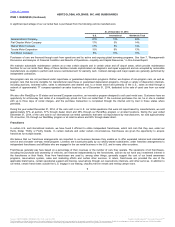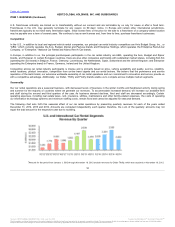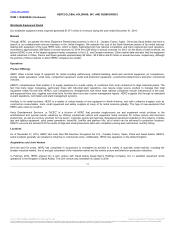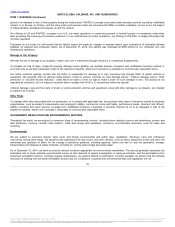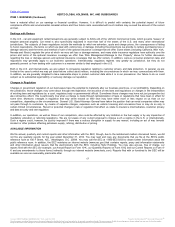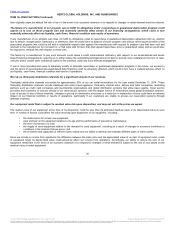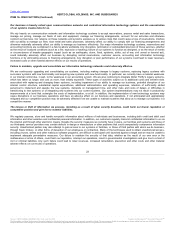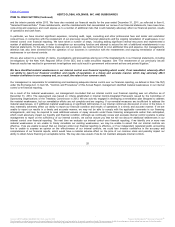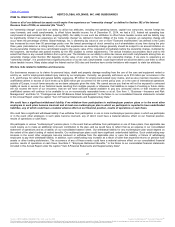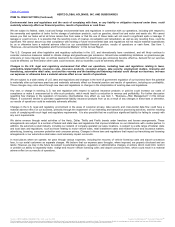Hertz 2014 Annual Report Download - page 30
Download and view the complete annual report
Please find page 30 of the 2014 Hertz annual report below. You can navigate through the pages in the report by either clicking on the pages listed below, or by using the keyword search tool below to find specific information within the annual report.
Table of Contents
Certain significant components of our expenses are fixed in the short-term, including minimum concession fees, real estate taxes, rent, insurance,
utilities, maintenance and other facility-related expenses, the costs of operating our information technology systems and minimum staffing costs.
Seasonal changes in our revenues do not alter those fixed expenses, typically resulting in higher profitability in periods when our revenues are
higher. The second and third quarters of the year have historically been the strongest quarters for our car rental business due to increased levels
of leisure travel and our equipment rental business, especially in the construction industry, has historically experienced decreased levels of
business from December until late spring and heightened activity during our third and fourth quarter until December. Any occurrence that disrupts
rental activity during these periods could have a disproportionately material adverse effect on our liquidity, cash flows and results of operations.
We have maintained like-kind exchange programs for our U.S. car rental business, HERC and Donlen for a number of years and Dollar Thrifty
maintained a similar program prior to our acquisition of Dollar Thrifty. Our like-kind exchange programs allow tax gains on the disposition of
vehicles in our car rental fleet to be deferred and have resulted in deferrals of federal and state income taxes for prior years. If a qualified
replacement vehicle is not purchased within a specific time period after vehicle disposal, then taxable gain is recognized. A material reduction in
the net book value of our car rental fleet, a material and extended reduction in vehicle purchases and/or a material downsizing of our car rental
fleet, for any reason, could result in reduced tax deferrals in the future, which in turn could require us to make material cash payments for U.S.
federal and state income tax liabilities.
The price and other terms at which we can acquire cars vary based on market and other conditions. For example, certain car manufacturers have
in the past, and may in the future, utilize strategies to de-emphasize sales to the car rental industry, which can negatively impact our ability to
obtain cars on competitive terms and conditions. Consequently, there is no guarantee that we can purchase a sufficient number of vehicles at
competitive prices and on competitive terms and conditions. Reduced or limited supplies of equipment together with increased prices are risks that
we also face in our equipment rental business. If we are unable to obtain an adequate supply of cars or equipment, or if we obtain less favorable
pricing and other terms when we acquire cars or equipment and are unable to pass on any increased costs to our customers, then our financial
condition, results of operations, liquidity and cash flows may be materially adversely affected.
For the years ended December 31, 2014 and 2013, 53% and 30% of the vehicles purchased for our combined U.S. and international car rental
fleets were program cars.
Manufacturers agree to repurchase program cars at a specified price or guarantee the depreciation rate on the cars during a specified time period.
To the extent the vehicles in our fleet are non-program cars, we have an increased risk that the market value of a car at the time of its disposition
will be less than its estimated residual value at such time. Any decrease in residual values with respect to our non-program cars and equipment
could also materially adversely affect our financial condition, results of operations, liquidity and cash flows.
The use of program cars enables us to determine our depreciation expense in advance and this is useful to us because depreciation is a
significant cost factor in our operations. Using program cars is also useful in managing our seasonal peak demand for fleet, because in certain
cases we can sell certain program cars shortly after having acquired them at a higher value than what we could for a similar non-program car at
that time. If there were fewer program cars in our fleet, these benefits would diminish and we would bear increased risk related to residual value. In
addition, the related depreciation on our car rental fleet and our flexibility to reduce the size of our fleet by returning cars sooner
19
Source: HERTZ GLOBAL HOLDINGS INC, 10-K, July 16, 2015 Powered by Morningstar® Document Research℠
The information contained herein may not be copied, adapted or distributed and is not warranted to be accurate, complete or timely. The user assumes all risks for any damages or losses arising from any use of this information,
except to the extent such damages or losses cannot be limited or excluded by applicable law. Past financial performance is no guarantee of future results.


